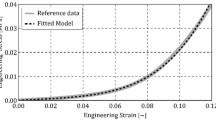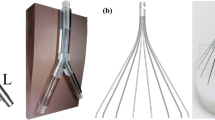Abstract
In this work, we use an in-vitro mechanical test to explore the resistance of biaxially stretched vena cava tissue against deep perforation and a methodology which integrates experimental and numerical modeling to identify constitutive fracture properties of the vena cava. Six sheep vena cava were harvested just after killing, and cyclic uniaxial tension tests in longitudinal and circumferential directions and biaxial deep penetration tests were performed. After that, we use a nonlinear finite element model to simulate in vitro penetration of the cava tissue in order to fit the fracture properties under penetration of the vena cava by defining a cohesive fracture zone. An iterative process was developed in order to fit the fracture properties of the vena cava using the previously obtained experimental results. The proposed solutions were obtained with fracture energy of 0.22 or 0.33 N/mm. In comparison with the experimental data, the simulation using \(\delta _{0}=0.01\,\hbox {mm}\), \(\delta _{r}=0.35\,\hbox {mm}\), and \(K=220\, \hbox {N}/\hbox {mm}^{3}\) parameters (\(F_{\hbox {max}}=0.92\)) is in good agreement with results from penetration experiments of cava tissue. It is noticeable that the parameter estimation process of the fracture behavior is more accurate than the estimation process of the elastic behavior for the toe region of the curve.












Similar content being viewed by others
References
Abouzgheib W et al (2008) Migration of an inferior vena cava filter to the pulmonary artery. Eur J Cardiothorac Surg 33:507
Alastrué V et al (2008) Experimental study and constitutive modelling of the passive mechanical properties of the ovine infrarenal vena cava tissue. J Biomech 41:3038–3045
Arabi M et al (2010) Retrievability of optional inferior vena cava filters with caudal migration and caval penetration: report of three cases. J Vasc Interv Radiol 21:923–926
Canham PB et al (1997) Contrasting structure of the saphenous vein and internal mammary artery used as coronary bypass vessels. Cardiovasc Res 34:557–567
Carew TE et al (1968) Compressibility of the arterial wall. Circ Res 23:61–86
Forsell C, Gasser TC (2011) The numerical implementation of invariant-based viscoelastic formulations at finite strains. An anisotropic model for the passive myocardium. J Biomech 44:45–51
Galhotra S et al (2007) Migration of the Günther Tulip inferior vena cava filter to the chest. J Vasc Interv Radiol 18:1581–1585
García A et al (2012) Evaluation of migration forces of a retrievable filter: experimental setup and finite element study. Med Eng Phys 34:1167–1176
Garcia-Palomares UM, Rodriguez JF (2002) New sequential and parallel derivative-free algorithms for unconstrained minimization. SIAM J Optim 13:79–96
Gasser GDTC, Gudmundson P (2009) Failure mechanisms of ventricular tissue due to deep penetration. J Biomech 42:626–633
Gasser TC et al (2006) Hyperelastic modelling of arterial layers with distributed collagen fibre orientations. J R Soc Interface 3:15–35
Goldhaber SZ (1992) Pulmonary embolism thrombolysis: a clarion call for international collaboration. J Am Coll Cardiol 19:246–247
Gregorio MAD et al (2008) Removal of retrievable inferior vena cava filters 90 days after implantation in an ovine model: Is there a time limit for removal? Arch Bronconeumol 44:591–596
Heit JA et al (2002) Relative impact of risk factors for deep vein thrombosis and pulmonary embolism: A population-based study. Arch Intern Med 162:1245–1248
Holzapfel GA et al (2007) Layer-Specific 3D Residual Deformations of Human Aortas with Non-Atherosclerotic Intimal Thickening. Ann Biomed Eng 35:530–545
Janjua M et al (2009) Inferior vena cava filter migration: updated review and case presentation. J Invasive Cardiol 21:606–610
Laborda A et al (2011) Laparoscopic demonstration of vena cava wall penetration by inferior vena cava filters in an ovine model. J Vasc Interv Radiol 22:851–856
Mahan CE et al (2011) Deep-vein thrombosis: A United States cost model for a preventable and costly adverse event. Thromb Haemost 106:405–415
Marquardt DW (1963) An algorithm for least-squares estimation of nonlinear parameters. Siam J Appl Math 11:431–441
Nicolas M et al (2015) In vitro comparison of Günther Tulip and Celect filters. Testing filtering efficiency and pressure drop. J Biomech 48:504–511
Nicolás M et al (2015) Numerical and experimental study of the fluid flow through a medical device. Int Comm J Heat Mass Transf 61:170–178
Ogden RW (1996) Non-linear elastic deformations. Dover, New York
Oh JC et al (2011) Removal of retrievable inferior vena cava filters with computed tomography findings indicating tenting or penetration of the inferior vena cava wall. J Vasc Interv Radiol 22:70–74
Ray CE, Kaufman JA (1996) Complications of inferior vena cava filters. Abdom Imaging 21:368–74
Ray CE et al (2006) Outcomes with retrievable inferior vena cava filters: a multicenter study. J Vasc Interv Radiol 17:1595–1604
Rhodin JAG (1980) Architecture of the vessel wall, handbook of physiology, the cardiovascular system, vol 2. American Physiological Society, Bethesda
Shergold OA, Fleck NA (2004) Mechanics of deep penetration of soft solids, with application to the injection and wounding of skin. Proc R Soc Lond A 460:3037–3058
Singer MA et al (2009) Computational modeling of blood flow in the TrapEase inferior vena cava filter. J Vasc Interv Radiol 20:799–805
Singer MA et al (2010) Design optimization of vena cava filters: an application to dual filtration devices. ASME J Biomech Eng 132:101006-10
Spencer AJM (1971) Theory of invariants. Continuum physics. Academic Press, New York, pp 239–253
Stewart SFC et al (2008) Effects of thrombosed vena cava filters on blood flow: flow visualization and numerical modeling. Ann Biomed Eng 36:1764–1781
Acknowledgments
Financial support for this research was provided by the Spanish Ministry of Economy and Competitiveness through research projects DPI2010-20746-C03-01, DPI2013-44391-P; the Department of Industry and Innovation (Government of Aragón) through the research group grant T88 and the Instituto de Salud Carlos III (ISCIII) through the CIBER initiative. The experimental tests have been performed by the ICTS “NANBIOSIS,” more specifically by the Tissue & Scaffold Characterization Unit (U13) of the CIBER in Bioengineering, Biomaterials & Nanomedicne (CIBER-BBN) at the University of Zaragoza.
Author information
Authors and Affiliations
Corresponding author
Rights and permissions
About this article
Cite this article
Hernández, Q., Peña, E. Failure properties of vena cava tissue due to deep penetration during filter insertion. Biomech Model Mechanobiol 15, 845–856 (2016). https://doi.org/10.1007/s10237-015-0728-3
Received:
Accepted:
Published:
Issue Date:
DOI: https://doi.org/10.1007/s10237-015-0728-3




